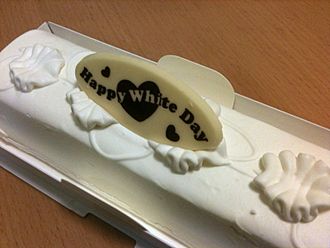White Day facts for kids
Quick facts for kids White Day |
|
|---|---|

White Day cake
|
|
| Observed by | Countries in East and Southeast Asia |
| Date | March 14 |
| Next time | 14 March 2026 |
| Frequency | Annual |
| Related to | Valentine's Day |
| White Day | |||||||
|---|---|---|---|---|---|---|---|
| Chinese name | |||||||
| Traditional Chinese | 白色情人節 | ||||||
| Simplified Chinese | 白色情人节 | ||||||
|
|||||||
| Burmese name | |||||||
| Burmese | အဖြူနေ့ | ||||||
| Vietnamese name | |||||||
| Vietnamese | Ngày Valentine Trắng | ||||||
| Korean name | |||||||
| Hangul | 화이트데이 | ||||||
|
|||||||
| Japanese name | |||||||
| Katakana | ホワイトデー | ||||||
|
|||||||
White Day is a special day celebrated on March 14 each year. It happens one month after Valentine's Day. On White Day, people give gifts back to those who gave them presents on Valentine's Day. This tradition started in Japan in 1978. Since then, it has become popular in many other Asian countries.
How White Day Started
Valentine's Day first came to Japan in 1936. But it did not become truly popular until the 1970s. In Japan, Valentine's Day was mostly a time for girls to show boys they liked them.
In 1977, a candy company in Fukuoka called Ishimuramanseido had an idea. They sold marshmallows to men on March 14. They called this day "Marshmallow Day."
White Day was first celebrated in 1978 in Japan. It was started by the National Confectionery Industry Association. They wanted it to be an "answer day" to Valentine's Day. The idea was that men should give gifts back to the women who gave them chocolate and other presents on Valentine's Day.
Soon, candy companies started selling white chocolate for this day. Now, men give both white and dark chocolate. They also give other gifts. These can be things like jewelry, special items, or even white clothes. Flowers are also a popular gift on White Day.
How White Day is Celebrated
White Day is celebrated on March 14, one month after Valentine's Day. In countries that celebrate White Day, Valentine's Day is usually when girls and women give chocolate gifts. These gifts can be bought or handmade. They are given to boys and men to show love, politeness, or as a social custom.
On White Day, the opposite happens. Men who received a "chocolate of love" (honmei-choco (本命チョコ, honmei-choco)) or "courtesy chocolate" (giri-choco (義理チョコ, giri-choco)) on Valentine's Day are expected to give gifts back to the women. Gifts are exchanged between boyfriends and girlfriends, friends, and even coworkers.
Traditionally, popular gifts for White Day include white chocolate, marshmallows, candy, and cookies. Other "white" items like jewelry, bags, and lotions are also common. Today, gifts do not have to be white.
Sometimes, people talk about "triple the return" (sanbai gaeshi (三倍返し, sanbai gaeshi)). This means that the gift a man gives back should be worth two or three times more than the Valentine's gift he received.
In recent years, White Day has become a little less popular. This might be because fewer "obligation chocolates" are given on Valentine's Day. Also, changing traditions in Japanese culture may play a part.
White Day Around the World
The idea of giving gifts back one month after Valentine's Day has spread. Many countries outside Japan now celebrate White Day. They usually celebrate it in a similar way. Some places where White Day is observed include China, South Korea, Taiwan, and Vietnam.
See also
 In Spanish: Día blanco para niños
In Spanish: Día blanco para niños

